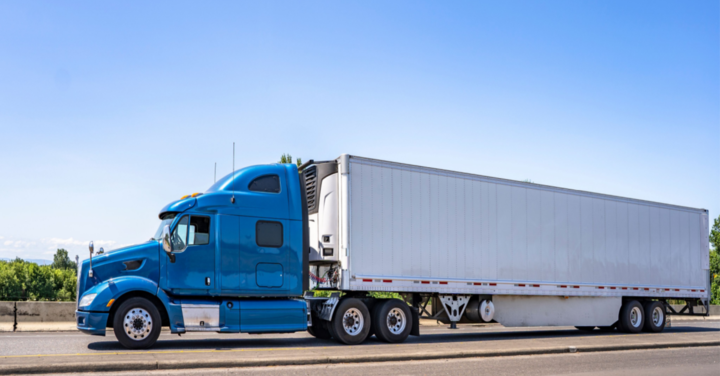Unpredictability is the biggest issue facing freight and logistics jobs and e-commerce today. With continuing recovery from COVID-related shutdowns and disruptions, the lingering pressures of market trends and consumer demands continue to focus on dry van freight, reefer truck freight, and overall truckload transportation services.
As highlighted by Logistics Management, the freight shipping industry continues to experience fluctuating volumes and rates as “van and reefer rates each saw $0.12 cent per mile increases in December, with vans at $1.94 and reefers at $2.30. Flatbed rates came in at $2.17 per mile, which rose 7 cents over December, marking the second-lowest tally of 2019. On the volume side, van volume slipped 1.5% from November to December, with reefer steady. Van volume was up 14% annually and reefers rose 9%.” Balancing the demand and available capacity of dry van and reefer truck modes can present a unique challenge for shippers and owner-operators. Here, we unravel the pros and cons of dry van trucking vs. reefer transportation.
What are Dry Van and Reefer Trucks?
The terms dry van freight and reefer truck freight get thrown around a lot. However, logistics and transportation managers today, especially those new to the industry, struggle to determine which mode works best for their shipping and hauling needs. Most cargo is shipped via one of these two modes. Matching the right cargo with the right transportation mode can help management overcome the challenges of supply chain trucking slowdowns and other obstacles still faced today.
Dry van cargo typically loads on fully enclosed trailers, specially designed to transport a wide range of freight quickly and securely. As the name implies, this type of shipping is best for cargo that needs no chilling or temperature considerations. Each trailer can haul up to 45,000 lbs, making this the go-to standard for moving non-perishable goods, whether for a short-distance local trip or a longer coast-to-coast delivery route. Dry van trucking services are versatile and adaptable to many types of cargo and shipping lanes.
A refrigerator truck, known in the industry as a reefer truck, is designed to carry perishable freight at low temperatures and provide a constant temperature range to prevent spoilage of goods and produce. Most long-distance reefer transport has large climate-controlled trailers that can hold many cold-sensitive or frozen goods. Reefer transportation helps distribute food and similar products to a wilder area than what would be possible without the temperature monitoring and controlling features.
Matching dry van freight and reefer truck freight to the correct shipping mode depends significantly on the travel lanes and what cargo gets hauled regularly. In terms of general volume, according to 2022 stats from Truckstop.com, there are fewer than a quarter as many reefers on the road compared to dry vans in the United States. The breakdown shows only an estimated 400,000 reefers to more than 1.7 million dry vans. That’s a lot of trailers on the road. Still, it also highlights the issue of securing capacity for loads and how important it is for shippers to choose between dry van vs. reefer truck capacity accurately.
Why Dry Van Transport is so Popular
In the dry van vs. reefer truck debate over what delivery method to use within the freight shipping industry, there are some key pros and cons to consider with dry van transportation:
Advantages
- Dry van freight vehicles can carry a wide range of cargo types from boxes to pallets to specialty loads and are perfect for short or long-haul runs.
- Dry transport help to protect cargo since the fully enclosed design protects contents from weather and offers an easy lock set up for added security.
- These dry trucks and vans are easy to use with drop and hook load methods and other delivery modes designed to speed up multiple loads and runs.
- Dry van shipping has more affordable freight rates, less maintenance, and less overhead than other hauling methods and trucking options.
Disadvantages
- The primary challenge of dry van freight trucks is the wood floor that can wear out quickly and requires frequent repair and maintenance to keep in good condition.
- Damage can occur with these shipping methods when the freight shifts and moves during shipping or through misuse of equipment during loading and unloading.
- Cargo can be damaged when doors are left open, during loading in inclement weather, or when post-pandemic guidelines are not properly followed.
- Dry vans limit what can get transported as cold and frozen goods will heat up, thaw, melt, and cause water damage and other issues, unlike reefer truck freight.
Why Reefer Truck Transport is so Popular
On the other side of the debate over freight shipping solutions, there’s no denying the popularity of reefer truck freight shipping due to its distinct pros and cons:
Advantages
- People will always need reefer truck freight options for food and drink items, medicine and cosmetics, and other items that need tight temperature control.
- Shippers can use reefer cargo space for non-temperature sensitive items and turn a reefer truck into a dry van for short-term use if that is needed,
- Reefer trailers are easy to secure, are sealed tightly against the elements, and offer excellent freight protection from the weather, theft, and other risks.
Disadvantages
- Reefer trucks and trailers have extra responsibilities to ensure everything works properly to control and monitor the cooling and temperature features.
- Loading and unloading times can be longer since reefer freight requires specialized handling, loading, and storage.
- Reefer truck freight vehicles have more equipment to maintain, and trucking salaries and pay rates are often higher as well due to specialized handling.
- Trailers must be pre-cooled before loading cargo, and the extra equipment means more fuel consumption, emissions, and waste than dry van freight.
Ultimately, the dry van vs. reefer truck debate must be settled by the shipper or driver as they understand what each load entails and what is and is not necessary to ensure a successful, on-time, in-full delivery. A firm grasp of current consumer trends and freight shipping industry demands makes it easier to find the best local carriers and drivers that fit the unique needs of dry van freight and reefer truck freight.
Using Real-Time Data and Predictive Analytics to Choose Dry Van Freight or Reefer Truck Freight
The final point to consider when choosing the suitable transportation van vs. reefer truck in the mode for dry or temp-sensitive cargo comes down to critical specifics about each load. Where it originated, Its destination, and the route along the way all impact how best to move any cargo from Point A to Point B. The local environment and road conditions are also important considerations. Quick and easy routes that usually do not face delays and disruptions might be best suited for dry van freight, while reefer truck freight needs more specialized and careful planning and monitoring of shipping routes and lanes.
Additionally, weather conditions and alerts need to be carefully considered by trucking companies for potential delays and impacts on cargo. Hurricane season is a prime example of cyclic weather that must be a concern when arranging shipping and transportation. In areas prone to storm delays, drivers must carefully consider dry van vs. reefer truck to ensure cargo gets to where it needs to go as safely as possible. C.H. Robinson brought this point up in June 2022: “NOAA’s outlook for the 2022 Atlantic hurricane season, which extends from June 1 to November 30, predicts a 65% chance of an above-normal season, a 25% chance of a near-normal season, and a 10% chance of a below-normal season.”
With considerations like these facing drivers and shipping managers, deciding whether to use dry vans or reefer trucks becomes one that cannot be overlooked or ignored. Overcoming supply chain bottlenecks and disruptions depends on carefully monitoring all contributing factors. Ensuring customers have access to the goods and products they need when they want then comes down to providing shippers use the correct delivery method and utilizing the right delivery vehicle for every load, whether short-haul or long-haul delivery.
Make the Right Choice for Dry Van vs. Reefer Truck Transport by Working With Industry Partners From the Start
Distinguishing the pros and cons of dry van freight shipping and reefer truck freight can be the factor that separates successful shippers from those that continue to struggle. Unpredictability continues to be the most significant obstacle keeping shipping companies from truly expanding services, which keeps the supply chain from fully recovering today. With the continued ripple effects from COVID-related shutdowns and disruptions, the lingering pressures on shipping and transportation service providers remain high. The need to match eh right cargo with the suitable shipping mode is higher than ever.
A firm grasp on current consumer trends and freight shipping industry demands makes the process easier with the unique features of dry vans and reefer trucks firmly in mind. Working with industry experts makes the entire process easier from start to finish. Contact AMX today to learn more about the dry van vs. reefer truck decision-making process.


